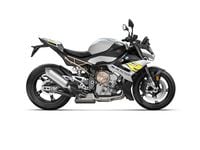BMW has announced some major revisions to its S 1000 RR-derived roadster, the S 1000 R, for 2021. Engine updates, chassis changes, more electronic aids as standard, plus a broader variety of optional upgrades join aesthetic revisions in the list of improvements for the coming model year. Pricing and availability for the 2021 S 1000 R will be announced at a later date.
The 999cc inline-four was updated to reduce weight, size, improve fuel consumption, and expand the potency of the powerband.
Component changes, such as lighter rocker arms, a combined oil and water pump, along with a reduction in the number of gear wheels in the engine, made it possible to achieve lighter weight and a slimmer profile. These updates also necessitated an engine housing update, changes to the camshaft profiles, exhaust, and intake system.
Related: 2020 BMW F 900 R Review First Ride
The compression ratio was increased slightly and engineers also altered the upper gear ratios so the mill will run at a lower rpm at higher speeds.
The changes result in an engine that pumps out 165 hp at 11,000 rpm and 84 pound-feet torque at 9,250 rpm. BMW promises a smooth linear torque curve and plenty of power and pull on tap wherever you find yourself in the rev range.
Additional powertrain elements include a slipper clutch with a lighter pull, adjustable throttle curves, and three ride modes.
The main frame itself is still an aluminum bridge design, but changes to the dual top tubes, the steering head, and engine mounts mean more load-bearing responsibility is transferred to the engine. This allowed for another weight savings of almost 3 pounds. The subframe and swingarm were also reconfigured to optimize both stiffness and flexibility.
Changes to the frame provide a narrower width at the knees of the rider.
Related: 2020 BMW S 1000 RR MC Commute Review
The rider triangle was altered as well, positioning riders in a more aggressive, forward-leaning position on the bike. Suspension components were updated, with a larger rear shock positioned further back toward the rear wheel than last year’s configuration. The fork was modified to optimize balance and stability in a variety of riding conditions. Both units are fully adjustable.
Light alloy wheels borrowed from the RR come standard and contribute to further overall weight savings.
A new master cylinder, lighter front brake discs, and ABS Pro as standard line out the revisions to the S 1000 R’s braking package.
Dynamic traction control, hill start control, and wheelie control all will come standard. Optional upgrade systems include pro versions of hill start and traction control, along with pro riding modes, an engine-brake system, shift assist pro, and the latest-generation dynamic damping control.
All information will flow to the rider through a 6.5-inch TFT display, which is Bluetooth compatible. When paired with the BMW Motorrad Connectivity app riders will have access to even more information and features.
The S 1000 R is more angular, compact, and aggressive in its stance. Designers sought to provide an even more stripped-down look to further differentiate the roadster from the RR. New LED lighting is featured throughout, and adjustable handlebar position, seat position, and levers allow riders to tailor the fit further without much hassle.
There will be numerous upgrade packages to choose from as well, focusing on improving rider comfort with things like heated grips and cruise control, or improving performance, with pro electronics packages and carbon fiber wheels.
























/cloudfront-us-east-1.images.arcpublishing.com/octane/VZZXJQ6U3FESFPZCBVXKFSUG4A.jpg)
/cloudfront-us-east-1.images.arcpublishing.com/octane/QCZEPHQAMRHZPLHTDJBIJVWL3M.jpg)
/cloudfront-us-east-1.images.arcpublishing.com/octane/HXOUJXQWA5HBHGRO3EMJIGFMVI.jpg)

/cloudfront-us-east-1.images.arcpublishing.com/octane/3TIWWRV4JBBOLDVGRYECVVTA7Y.jpg)
/cloudfront-us-east-1.images.arcpublishing.com/octane/KIX5O23D5NAIBGFXBN3327DKZU.jpg)
/cloudfront-us-east-1.images.arcpublishing.com/octane/7GJYDUIPXRGMTMQKN6ONYOLBOU.jpg)
/cloudfront-us-east-1.images.arcpublishing.com/octane/MUQLOVLL2ZDGFH25ILABNBXKTI.jpg)
/cloudfront-us-east-1.images.arcpublishing.com/octane/TNOU5DNE2BC57MFPMGN2EIDXAM.jpg)
/cloudfront-us-east-1.images.arcpublishing.com/octane/GTCXACQGJ5HAPDTGWUQKDEH44E.jpg)
/cloudfront-us-east-1.images.arcpublishing.com/octane/S35YGSEMEZB4BLTDJTSZPF4GLA.jpg)
/cloudfront-us-east-1.images.arcpublishing.com/octane/5UOT6HPX2JFMRJAX6EH45AR4MQ.jpg)
/cloudfront-us-east-1.images.arcpublishing.com/octane/OKWOJWAKP5EP3OACCRRWPCIX2Q.jpg)
/cloudfront-us-east-1.images.arcpublishing.com/octane/2WF3SCE3NFBQXLDNJM7KMXA45E.jpg)
/cloudfront-us-east-1.images.arcpublishing.com/octane/G4MG6OUCJNBSHIS2MVVOTPX65E.jpg)
/cloudfront-us-east-1.images.arcpublishing.com/octane/IIGGWFOTOJGB7DB6DGBXCCMTDY.jpg)
/cloudfront-us-east-1.images.arcpublishing.com/octane/QSTCM6AVEZA5JJBUXNIQ3DSOF4.jpg)
/cloudfront-us-east-1.images.arcpublishing.com/octane/U4I7G625B5DMLF2DVIJDFZVV6M.jpg)
/cloudfront-us-east-1.images.arcpublishing.com/octane/B6XD6LS6IVCQPIU6HXDJSM3FHY.jpg)
/cloudfront-us-east-1.images.arcpublishing.com/octane/ICL63FEDDRDTTMINYICCEYGMDA.jpg)
/cloudfront-us-east-1.images.arcpublishing.com/octane/FCGZHQXRBZFLBAPC5SDIQLVF4I.jpg)
/cloudfront-us-east-1.images.arcpublishing.com/octane/WNOB6LDOIFFHJKPSVIWDYUGOPM.jpg)

/cloudfront-us-east-1.images.arcpublishing.com/octane/X33NU3E525ECRHXLNUJN2FTRKI.jpg)